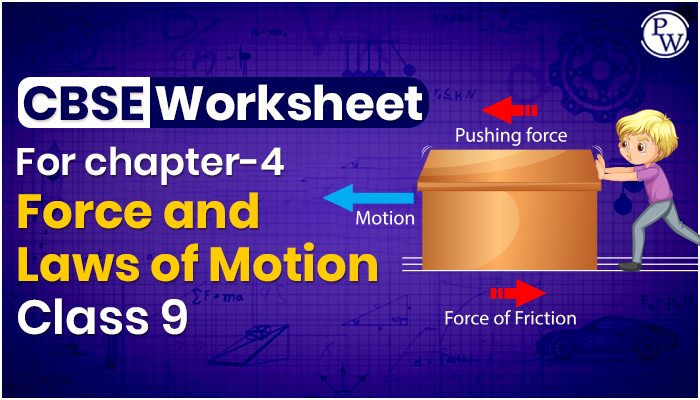
CBSE Worksheet for chapter-4 Force and Laws of Motion class 9
Worksheet For class 9
Find CBSE Worksheet for chapter-3 Motion class 9
CLASS-9
BOARD: CBSE
Physics Worksheet - 4
TOPIC: Force
For other CBSE Worksheet for class 9 Science check out main page of Physics Wallah.
Summary
- Galileo’s Experiment, Inertia and its types, Newton’s First Law of motion
- Momentum, Newton’s second law of motion, Units of force
- First law of motion by second law of motion

SECTION I – OBJECTIVE
-
Newton’s second law of motion:
- Defines force
- Defines inertia
- Gives measure of force
- None of these
-
Newton’s first law of motion is:
- Qualitative
- Quantitative
- Both quantitative and qualitative
- Neither qualitative nor quantitative
-
The law which defines force is:
- Newton’s third law
- Newton’s first law
- Newton’s second law
- None of these
-
Mass measures amount of ---------- in a body:
- Inertia.
- Motion.
- Velocity.
- Acceleration.
-
A man sitting in a train in a motion is facing the engine. He tosses a coin up, the coin falls behind him. The train is moving:
- Forward with uniform speed
- Backward with uniform speed
- Forward with acceleration
- Forward with retardation
-
A body A has a mass 5 kg. Now this is broken into two pieces. Is inertia of the two pieces combined more than the inertia of A when it was not broken:
- Yes
- No
- May or may not be
- None of these
-
Newton’s second law of motion is
- Qualitative
- Quantitative
- Both qualitative and quantitative
- Neither qualitative nor quantitative
-
When a force 1N acts on mass of 1kg, which is able to move freely, the object moves with a/an:
- Speed of 1 m/s
- Speed of 1 km/s
- Acceleration of 10 m/s 2
- Acceleration of 1 m/s 2
-
A body of mass M strikes against wall with a velocity’ v’ and rebounds with the same velocity.
Its change in momentum is:- Zero
- Mv
- -Mv
- -2 Mv
-
A body of mass 5 kg undergoes a change in speed from 20 m/s to0.20 m/s. The momentum:
- Increases by 99 kgm/s
- Decreases by 99 kgm/s
- Increases by 101 kgm/s
- Decreases by 101 kgm/s
SECTION II - SUBJECTIVE
- Define force.
- Define inertia. State its three types.
- State Newton’s first law of motion.
- A force F 1 acting on a body of 2 kg produces an acceleration of 2.5 m/s 2 . Another force F 2 acting on another body of mass 5 kg produces an acceleration of 2 m/s 2 . Find the ratio F 2 /F 1.
- A force of 20 N acting on a mass m 1 produces an acceleration of 4 m/s 2 . The same force is applied on mass m 2 then the acceleration produced is 0.5 m/s 2 . What acceleration would the same force produce, when both masses are tied together ?
Solutions
| 1. (C) | 2. (A) | 3. (D) | 4. (A) | 5. (C) | 6. (B) | 7. (B) | 8. (D) | 9. (D) | 10. (B) |
Subjective Problems:
- Answer F 2 /F 1 = 10/5= 2.
-
For mass m
1
=F/a = 5 kg.
For mass m 2 = F/a = 40 kg.
When m 1 and m 2 are tied together then a = 0.44 m/s 2
Frequently Asked Question (FAQs)
Q1. Which chapter is force and laws of motion class 9?
Ans. If you are a student of class 9 who is using the NCERT Textbook to study Science, you must come across Chapter 9, Force and Laws of Motion.
Q2. Why do we fall ill notes?
Ans. The various causes of diseases are:
- Pathogens (virus, bacteria).
- Lack of nutritious diet/balanced diet.
- Lack of public health services.
Q3. What are balance and unbalanced forces?
Ans. The force is equal in size and opposite in a direction. Balanced force does not result in any change in motion. It does not fit. Strength: the force applied to an object in the opposite direction equal in size. Unequal force leads to changes in motion.
Q4. Why does an object stay at rest?
Ans. Inertia causes a moving object to continue moving at the same velocity (speed and direction) unless the force is working on it to change speed or direction. It also causes the resting object to stay at rest.
Q5. Is weight a force?
Ans. Weight is a force, a vector quantity that has both magnitude and direction. In a plane, the weight is always directed to the earth's center.
For other CBSE Worksheet for Class 9 Science check out main page of Physics Wallah









